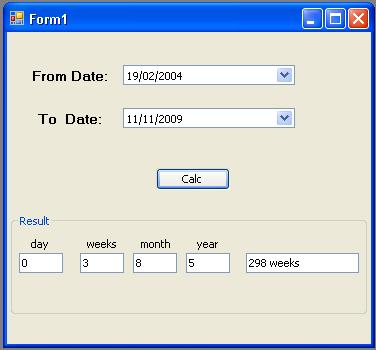
Introduction
During my investigation of the DateTime and TimeSpan classes, I faced the following question several times, and unfortunately, I didn't find an answer to it.
How can I get the difference between two dates in number of days, weeks, months, and years? I tried to use the Subtract method of the DateTime class, and it gave me the difference in TimeSpan, from which I can get the duration in days, hours, and so on... but how can I get the difference in larger date parts?
I found it a very common requirement to display the date difference between two dates with high precision, considering leap years and the number of days in each month.
So I decided to write my own library (DateCalculator_Lib) which provides to its user a complete set of properties for all required date parts (days, weeks, months, years) along with some extra properties like number of leap years and a collection containing the accrual of each month during the difference period, and a group of properties representing each date part total accrual in the difference period, like total number of days, months,......etc.
Using the Code
All you need is to add a reference to DateCalculator.dll in your .NET project and the using statement for the DateCalculator namespace, then create an object from the DateCalculator class which will need the start and end dates in its constructor.
After that, just call the public CalculateDateDifference method from your object, and it will calculate each date difference part and assign it to the appropriate property.
Use those read only properties to retrieve all your needs....
The attached demo project contains all the previously explained steps.
using DateCalculator;
private void button1_Click(object sender, EventArgs e)
{
DateCalculator.DateCalculator DC = new DateCalculator.DateCalculator
( this.dateTimePicker1.Value, this.dateTimePicker2.Value);
DC.CalculateDateDifference();
this.day_txt.Text = DC.Days.ToString();
this.week_txt.Text = DC.Weeks.ToString();
this.month_txt.Text = DC.Months.ToString();
this.year_txt.Text = DC.Years.ToString();
}
Algorithm Explanation
This library depends on a well known algorithm called "Goal Seek" algorithm; we start from the "Start Date" and go on until we reach the "End Date", which is our goal...during the journey, we collect information by accumulating days and months and leap years inside the period between the start and end dates.
The algorithm depends on a container "Integer array" that contains the number of days in each month except February, as this month is the differentiator between normal and leap years.
And the algorithm logical steps are as follows:
- If our Goal -->>"End date" is not reached, continue.
- Check if current month is February or not, and accumulate days and months.
- Update the
public properties. - Check the termination condition "Did we reach the goal or not".
- If not, get the next month index and continue in the loop.
- If we exceed the goal, we seek it by going forward and backward until we stop on the end date.
Finally, after finishing this loop, all public properties will contain the accumulated information collected through the cycle.
History
- 19th November, 2009: Initial post
